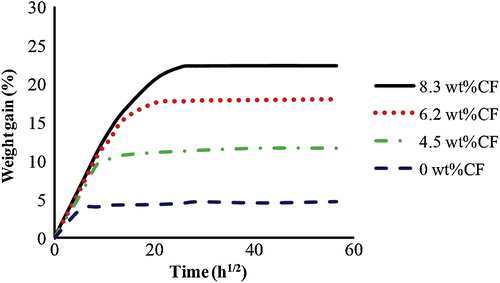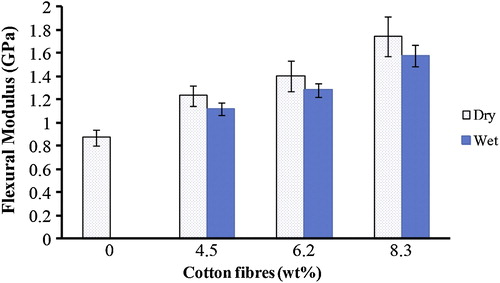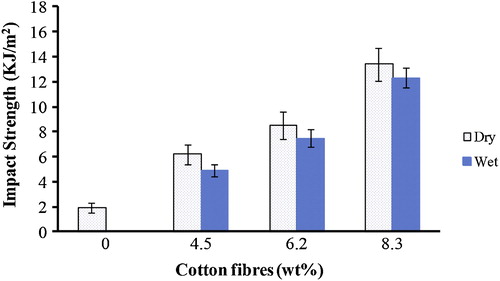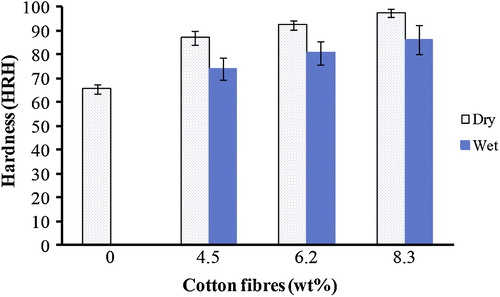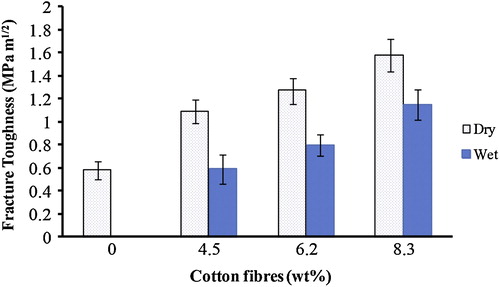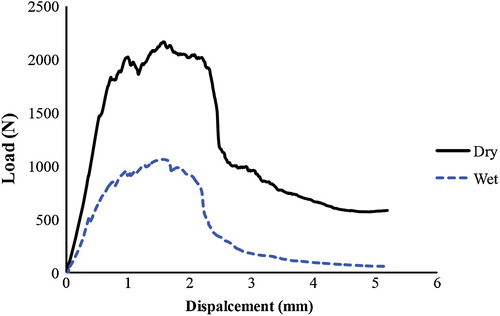 ?Mathematical formulae have been encoded as MathML and are displayed in this HTML version using MathJax in order to improve their display. Uncheck the box to turn MathJax off. This feature requires Javascript. Click on a formula to zoom.
?Mathematical formulae have been encoded as MathML and are displayed in this HTML version using MathJax in order to improve their display. Uncheck the box to turn MathJax off. This feature requires Javascript. Click on a formula to zoom.Abstract
Cotton fabric (CF) reinforced geopolymer composites are fabricated with fibre loadings of 4.5, 6.2 and 8.3 wt%. Results show that flexural strength, flexural modulus, impact strength, hardness and fracture toughness are increased as the fibre content increased. The ultimate mechanical properties were achieved with a fibre content of 8.3 wt%. The effect of water absorption on mechanical and physical properties of CF reinforced geopolymer composites is also investigated. The magnitude of maximum water uptake and diffusion coefficient is increased with an increase in fibre content. Flexural strength, modulus, impact strength, hardness and fracture toughness values are decreased as a result of water absorption. Scanning electron microscopy (SEM) is used to characterise the microstructure and failure mechanisms of dry and wet cotton fibre reinforced geopolymer composites.
1 Introduction
Geopolymers are aluminosilicate inorganic polymers formed by polymerisation of aluminosilicates with alkaline solutions. Geopolymers have several desirable attributes which include good mechanical properties and durability [Citation1]. They are environmentally friendly, being derived from natural materials, and because they can be prepared at room temperature they do not emit the high levels of carbon dioxide associated with the preparation of Portland cement [Citation2,Citation3]. However, despite their many desirable attributes such as relatively high strength, elastic modulus and low shrinkage, geopolymers suffer from brittle failure like most ceramics. This limitation may be readily overcome with fibre reinforcement as in high performance polymer–matrix composites. Hitherto, the most common fibre reinforcements used in geopolymer composites have been based on carbon, basalt, glass and polyvinyl alcohol fibres [Citation4–Citation7].
Table 1 Chemical analysis of cotton.
Table 2 Properties and structure of cotton fabric.
Current concerns over the environment and climate change have given rise to an increasing interest in replacing the synthetic fibres currently used in geopolymer composites or other brittle matrices with natural plant fibres [Citation8,Citation9]. The advantages of natural plant fibres over traditional glass fibres are low density, low cost, biodegradability, acceptable specific properties, less wear during processing and low energy consumption during extraction. The wide variety of natural fibres available locally is an added benefit to manufacturers the composites [Citation10,Citation11].
Natural fibres have a few disadvantages when used as reinforcements, such as higher moisture absorption which brings about dimensional changes thus leading to micro-cracking and poor thermal stability. The moisture absorption by the composites containing natural fibres had several adverse effects on their properties and affected their long-term performance. Water absorption can lead to swelling of the fibre, forming voids and micro-cracks at the fibre–matrix interface region which may result in a reduction of the mechanical properties and dimensional stability of composites [Citation12–Citation14]. Several studies in the use of natural fibre reinforced polymeric composites have reported that water molecules act as a plasticiser agent in the composite material, which normally leads to a decrease in the mechanical properties of the composites after water absorption [Citation15–Citation17].
Moisture diffusion in composites may degrade mechanical properties by three different mechanisms [Citation18,Citation19]. The first mechanism involves the diffusion of water molecules inside the micro gaps between polymer chains. The second mechanism involves capillary transport into gaps and flaws at interfaces between fibre and matrix. The third mechanism involves swelling effects which propagate microcracks in the matrix. In general, moisture diffusion in a composite depends on factors such as volume of fibre, voids, viscosity of matrix, humidity and temperature.
In order to promote the wider use of such materials in high-performance applications, it is essential to consider the effect of moisture absorption and water uptake on their physical and mechanical properties. However, according to the best knowledge of authors, no research was reported about the effect of water absorption on the mechanical properties of cotton fabric (CF) reinforced geopolymer composites. In this research, CF-reinforced geopolymer composites with different fibre contents (4.5, 6.2 and 8.3 wt%) have been successfully fabricated. The effect of fibre content on the mechanical properties has been investigated in terms of flexural strength, modulus, impact strength, hardness and fracture toughness. The effect of water absorption on the mechanical properties of composites has also been studied as a function of fibre content. Scanning electron microscopy (SEM) has been used to investigate the morphology, micro-structure and failure mechanisms of CF-reinforced geopolymer composites.
2 Experimental procedure
2.1 Materials
CF of 30 cm × 7.5 cm was used as a reinforcing material for the fabrication of geopolymer composites. The chemical composition and the physical properties of CF are shown in and respectively [Citation20]. Low calcium fly-ash (ASTM class F), collected from the Collie power station in Western Australia, was used as the source material of the geopolymer matrix. The chemical compositions of fly-ash are shown in . The alkaline activator for geopolymerisation was a combination of sodium hydroxide solution and sodium silicate grade D solution. Sodium hydroxide flakes of 98% purity were used to prepare the sodium hydroxide solution. The chemical composition of sodium silicate solution was 14.7% Na2O, 29.4% SiO2 and 55.9% water by weight.
Table 3 Chemical composition of fly-ash.
2.2 Sample preparation
To prepare the CF-reinforced geopolymer composites the fabric was initially pre-dried for 60 min at 70 °C in an oven. A thin layer of geopolymer matrix was spread into the wooden mould and the first layer of CF was laid upon it and fully impregnated (wet out) with geopolymer paste with a roller before placing the next layer. This process was repeated for the desired number of cotton fibre layers. In each specimen, the final layer was geopolymer matrix. Pure samples of geopolymer were prepared as controls by slowly adding dry fly ash to the alkaline solution in a Hobart mixer until the mixture became homogeneous. This was then poured into a wooden mould. The alkaline solution to fly-ash ratio was kept at 0.35, and the ratio of sodium silicate solution to sodium hydroxide solution (8 M concentration) was fixed at 2.5.
After casting, each sample was pressed with a 20 kg load for 5 h, after which the specimens were covered with plastic film cured at 80 °C in an oven for 24 h and then allowed them to cool down to laboratory conditions before being removed from the mould. Then rectangular bars with dimensions of 80 mm × 20 mm × 20 mm for both dry and wet conditions were prepared.
2.3 Water absorption test
The composite specimens used for moisture absorption test were immersed in a water bath at room temperature for longer period to reach equilibrium. At regular intervals, the specimens were taken out from the water and wiped with filter paper to remove surface water and weighed with digital scale (AA-200, Denver Instrument Company, USA). The samples were re-immersed in water to permit the continuation of sorption until saturation limit was reached after 133 days. The weighing was done within 30 s, in order to avoid the error due to evaporation. The percentage of the water content (Mt) was determined using the following equation [Citation21]:(1a)
(1a) where Wt is the weight of the sample at time t and Wo is the initial weight of the sample.
The water absorption behaviour in the samples can be studied as Fickian behaviour. Therefore, the following formula has been used [Citation21,Citation22]:(1b)
(1b) where Mt is the water content at time t, M∞ is the equilibrium water content, D is the diffusion coefficient and h is the sample thickness.
2.4 Mechanical testing
2.4.1 Flexural strength and modulus
Rectangular bars with a length of 40 mm were cut from the fully cured samples and subjected to three-point bend tests to evaluate their flexural strength and modulus. A LLOYD Material Testing Machine (50 kN capacity) with a displacement rate of 1.0 mm/min was employed to perform the tests. In total, five specimens of each composition were tested. The flexural strength (σF) was determined using the following equation:(2)
(2) where Pm is the maximum load at crack extension, S is the span of the sample, B is the specimen width and W is the specimen thickness or depth. The flexural modulus was computed using the initial slope of the load–displacement curve, ΔP/ΔX, using the following formula:
(3)
(3)
2.4.2 Impact strength
A Zwick Charpy impact tester with a 1.0 J pendulum hammer was employed to determine the impact strength. For each composition, five bars of 40 mm length were tested. The impact strength (σi) was calculated using the following equation:(4)
(4) where E is the impact energy required to break a sample with a ligament of area A.
2.4.3 Rockwell hardness
The hardness of geopolymer composites was measured using an Avery Rockwell hardness tester at hardness scale H. Before measurement, the surfaces of test samples were polished using a Struers Pedimat polisher, finishing with 10 μm grade diamond paste.
2.4.4 Fracture toughness
Rectangular bars of 80 mm in length with a cross-sectional dimension of 20 mm × 20 mm were used in fracture toughness measurements. Subsequently, a crack with a length to thickness (depth) (a/W) ratio of 0.4 was introduced in each specimen by means of a 0.4 mm diamond blade. The fracture toughness (KIC) was calculated using the equation proposed by Low et al. [Citation23]:(5a)
(5a) where Pm is the maximum load at crack extension, S is the span of the sample, B is the specimen width, W is the specimen thickness (depth), a is the crack length and f(a/W) is the polynomial geometrical correction factor given by the equation below [Citation23]:
(5b)
(5b)
2.5 Microstructure examination
SEM was carried out using a Tescan Lyra SEM machine. The SEM investigation was performed in detail on the fractured surfaces of the composites. In order to avoid charging, the specimens were coated with a thin layer of gold before observation.
3 Results and discussion
The results obtained from this experimental study can be divided into two parts. The first part considers water absorption behaviour of CF-reinforced geopolymer composites and the second evaluates the effects of water absorption at room temperature on the mechanical properties.
3.1 Water absorption behaviour
shows the percentage of water uptake as a function of square root of time of geopolymer composite samples reinforced with 0, 4.5, 6.2 and 8.3 wt% CF due to immersion in tap water for 133 days at room temperature. It can be seen that the water absorption increases with increase in fibre contents. The increase in water absorption is due to the hydrophilic nature of natural fibre and the greater interfacial area between the fibre and the matrix [Citation15]. The maximum water uptake and the diffusion coefficient values increased for all composite specimens as the cotton fibre content increased (see ). The water absorption of all specimens was high in the early stages of exposure, after which it slowed down and reached saturation level after prolonged time, following a Fickian diffusion process. The initial rate of water absorption and the maximum water uptake increase, as the fibre loading increases in all natural fibre composite samples [Citation15]. This phenomenon can be explained by considering the water uptake characteristics of cotton fibre. When natural fibre-reinforced composite is exposed to moisture, the hydrophilic nature of fibre, in this case cotton, causes the fibre to absorb water and swell. As a result, micro-cracking of the geopolymer composite occurs. The high cellulose content in cotton fibre absorbs extra water that penetrates the interface through these micro-cracks, creating swelling stresses that lead to composite failure [Citation24]. The more the composite cracks, the more capillarity and transport via micro-cracks become active. The capillary mechanism involves the flow of water molecules along fibre–matrix interfaces and diffusion through the bulk matrix. Water molecules actively attack the interface, resulting in de-bonding of the fibre and the matrix [Citation15].
Table 4 Maximum water uptake and diffusion coefficient (D) of CF/geopolymer composites.
3.2 Effect of water absorption on mechanical properties
The effect of water absorption on the mechanical properties of CF-reinforced geopolymer composites was investigated after placing specimens in water for 133 days at room temperature and comparing them with samples of the same composites kept in dry conditions.
3.2.1 Flexural strength
The effect of fibre content on the flexural strength of dry CF reinforced geopolymer composites is shown in . In dry condition, the flexural strength increased as fibre content increased. The flexural strength of neat geopolymer increased from 8.3 to 15.8, 19.7 and 28.1 MPa due to the addition of 4.5, 6.2 and 8.3 wt% CF, respectively. This enhancement in flexural strength of CF-reinforced geopolymer composites is due to the ability of natural fibre to resist bending forces and good stress transfer from the matrix resulting in improve strength properties [Citation25].
The effect of water absorption on flexural strength of CF reinforced geopolymer composites is also shown in . It can be seen that the flexural strength of composites decreased markedly after water absorption. Compared to the dry composites, the flexural strength of the composites reinforced with 4.5, 6.2 and 8.3 wt% CF deceased from 15.8, 19.7 and 28.1 to 9.3, 13.4 and 21.4 MPa, respectively. This could be due to the fact that the immersion of the composite samples in water affects the interfacial adhesion between fibre and matrix and creates de-bonding, leading to a decrease in mechanical properties. When the fibre–matrix interface was accessible to moisture in the environment the cotton fibres swelled. This resulted in the development of shear stress at the interface, and led to the ultimate de-bonding of the fibres, delamination and loss of structural integrity [Citation26].
Water absorbed in polymers is generally as either free water or bound water as reported by Azwa et al. [Citation27] (see ). Water molecules which are relatively free to travel through the micro voids and pores are identified as free water, while those dispersed in the polymer matrix and attached to the polar groups of the polymer are designated as bound water [Citation28]. In a wet environment, water molecules penetrate in natural fibre-reinforced composite through micro-cracks and reduce interfacial adhesion of fibre with the matrix. This causes swelling of the fibres, which may create micro-cracks in the matrix and may eventually lead to debonding between the fibre and the matrix [Citation27]. A schematic illustration of this process is presented in .
Fig. 3 Free water and bound water in polymer matrix [Citation27].
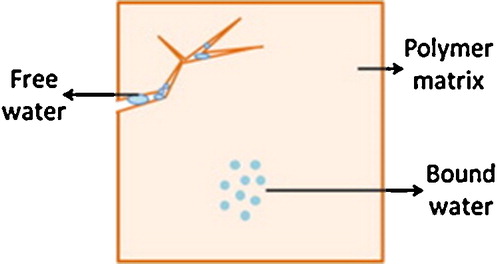
Fig. 4 Effect of water on fibre–matrix interface [Citation27].
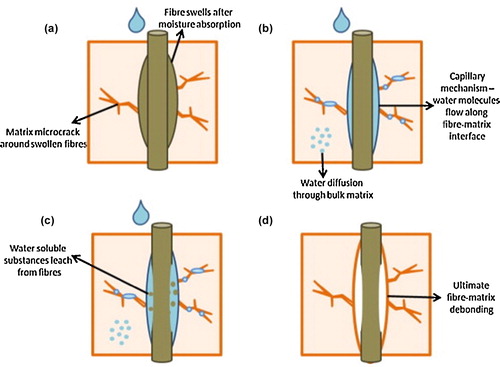
Dry cotton fibre constructed from fibrils of cellulose is fairly stiff and rigid. The cellulose molecules are held tightly together inside the fibrils by bonds established between molecules lying closely alongside one another. Water, however, can penetrate this cellulose network and move into the capillaries and spaces between the fibrils. In this situation, water molecules tend to force the cellulose molecules apart, reducing the forces that hold them together and destroying their rigidity, because water acts as a plasticiser and permits the cellulose molecules to move. Consequently the mass of the cellulose is softened, and this changes the dimensions of the fibre under applied force [Citation15,Citation16]. According to Ray and Rout [Citation29], water molecules attract the hydrophilic groups of natural fibres and react with the hydroxyl groups (–OH) of the cellulose molecules to form hydrogen bonds. A schematic illustration of moisture absorption by natural fibres is presented in .
Fig. 5 Schematic of moisture absorption by natural fibre [Citation29].
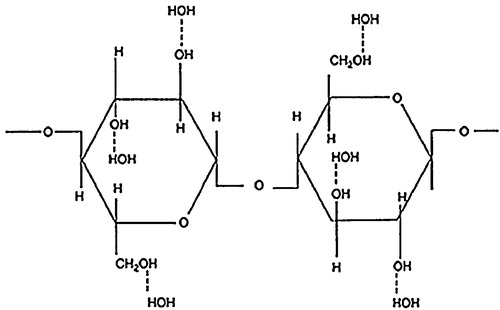
3.2.2 Flexural modulus
The flexural modulus values of different cotton fibre reinforced geopolymer composites in dry and wet conditions are shown in . In the dry samples, the flexural modulus increased as the fibre content increased. The addition of 4.5, 6.2 and 8.3 wt% CF increased the flexural modulus from 0.87 to 1.23, 1.4 and 1.74 GPa, respectively, compared to pure geopolymer: thus, an increase in the fibre content of the composite material resulted in an increase in flexural modulus. The improvement in flexural modulus is believed to be due to the higher initial modulus of the natural fibres acting as backbones in the composites [Citation30,Citation31]. This is supported by earlier studies, which have reported significant increases in the flexural modulus of natural fibre-reinforced polymer composites. For example, Ma et al. [Citation32] reported that the flexural modulus of winceyette fibre-reinforced thermoplastic starch composites increased from 45 MPa for neat resin to approximately 140 GPa as the fibre content increased from 0% to 20%.
The influence of water absorption on the flexural modulus of CF reinforced geopolymer composites is also shown in , which shows a considerable decrease in the flexural modulus of the wet samples when compared to the dry samples. The reason for this is that in the wet samples absorbed water molecules and reduced the intermolecular hydrogen bonding between cellulose molecules in the fibre and established intermolecular hydrogen bonding between the cellulose molecules and water molecules in the fibre, thereby reduced the interfacial adhesion between the fibre and the matrix and resulting in decreased flexural modulus [Citation15]. illustrates the typical flexural stress–strain curves for geopolymer composites before and after being placed in water. It can be observed that the maximum stress in dry composite significantly decreased after immersion in water for a prolonged period. This drop can be attributed to degradation in the fibre–matrix interfacial bonding caused by the water absorption [Citation11].
3.2.3 Impact strength
Impact strength is an important property that gives an indication of overall material toughness. Impact strength of fibre-reinforced polymer is governed by the matrix–fibre interfacial bonding, and the properties of both matrix and fibre. When the composites undergo a sudden force, the impact energy is dissipated by the combination of fibre pullouts, fibre fracture and matrix deformation [Citation10]. Normally in fibre-reinforced polymer composites, the impact strength increases as fibre content increases because of the increase in fibre pull out and fibre breakage [Citation33].
The effect of fibre contents on the impact strength of dry and wet cotton fibre-reinforced geopolymer composites is shown in . It can be seen that impact strength significantly increased as the CF content increased in dry composites. The presence of CF layers in the matrix increases the ability of these composites to absorb impact energy. In dry conditions, the addition of CF with contents of 4.5, 6.2 and 8.3 wt% increases the impact strength from 1.9 to 6.2, 8.5 and 13.4 KJ/m2, respectively compared to unreinforced geopolymer. Similar remarkable improvements in impact strength were reported by Graupner [Citation24], who observed that the addition of cotton fibre increased the impact strength of pure poly(lactic acid) matrix. He concluded that the increase was due to greater elongation of cotton fibres at break. Fibres containing much cellulose generally have high elongation at break values. Cotton has a cellulose content of about 88–96%. Elongation at break and impact strength are directly correlated. The high elongation at break of cotton fibres increased the elongation at break in the composites, leading to higher impact strength.
However, impact strength is adversely affected by water absorption. The decrease in impact properties after water immersion can be related to the weak fibre–matrix interface, which resulted in a reduction of the mechanical properties and dimensional stability of composites [Citation14].
3.2.4 Hardness
The effect of cotton fibre contents on the hardness of the cotton fibre-reinforced geopolymer composites is presented in . The hardness of geopolymer composites reinforced with 4.5, 6.2 and 8.3 wt% CF increased from 65.5 to 87.22, 92.32 and 86.4 HRH, respectively relative to the neat geopolymer. This enhancement in hardness is caused by the distribution of the test load on the fibres, which decreased the penetration of the test ball on the surface of the composite material and consequently improved the hardness of this material [Citation34].
However, hardness is affected by water absorption, as shown in . Hardness decreases in all cotton fibre-reinforced samples in wet condition, and is associated with the weakening of interface between the geopolymer matrix and the cotton fibre caused by the water absorption. This decrease has been reported by other researchers working with natural fibre-based composites. Dhakal et al. [Citation35] reported that as water absorption increased, the hardness of flax fibre-reinforced composites decreased, and found that the deformation depth increased for water-immersed specimens compared to dry ones, due to the hydrophilic nature of the fibres, and eventually led to the formation of a weak fibre–matrix interface. In the case of cotton fibre-reinforced geopolymer composites when water uptake reaches saturation level, the bound water and the free water remain in the composite as a reservoir. This leads to softening of the fibres and weakening of the fibre matrix adhesion, resulting in reduced material properties.
3.2.5 Fracture toughness
The effect of cotton fibre contents on the facture toughness of geopolymer composites is presented in . The addition of cotton fibre gradually increased the fracture toughness of CF reinforced geopolymer composites compared to net geopolymer. Cotton fibres play a significant role in enhancing the facture toughness of the matrices through several energy-absorbing characteristics such as fibre rupture, fibre–matrix interface debonding, fibre pull-out and fibre-bridging, which slow crack propagation and therefore increase the fracture energy [Citation36–Citation40]. The fracture toughness of geopolymer reinforced with 4.5, 6.2 and 8.3 wt% CF increased from 0.57 to 1.09, 1.27 and 1.58 MPa m1/2, respectively compared to neat geopolymer. This significant enhancement in facture toughness at higher CF content is due to extensive fibre pull-out, fibre fracture and fibre-bridging of cotton fibres.
The effect of water absorption on fracture toughness of CF-reinforced geopolymer composites is also shown in . The fracture toughness for all wet composites considerably decreased compared to the dry composites, as a result of the severe damage to fibre structure and interfacial bonding between the cotton fibre and the geopolymer matrix caused by the absorbed water. Typical load–displacement curves for the composites before and after immersion in water are shown in . It can be seen that the maximum peak load of dry composite significantly decreased after immersing in water for a prolonged period. The areas under the curve indicate that the wet composite achieved lower fracture toughness than the dried composite. This reduction can be explained as the effect of moisture absorption causing swelling of fibres, which creates micro-cracks in the sample, leading to lower fracture toughness [Citation24]. In addition, water molecules diffuse into the fibre–matrix interfaces through these micro-cracks, which cause debonding of the fibres and thus weakens the fibre–matrix interface [Citation14].
The reduction in fracture toughness can be attributed to internal pore water pressure which developed in the limited pore spaces of the wet geopolymer composites. Water does not move into a pore when adjacent pores are completely filled with water. As a result, a very high disjoining pressure is produced due to the capillary action, leading to early crack propagation under external loading. The fracture resistance of wet geopolymer composites thus becomes lower than that of dry composites [Citation41].
The microstructures of dry and wet composites reinforced with 8.3 wt% CF are shown in a–d. a and b shows severe matrix cracking and degradation of the interfacial adhesion between the fibres and the matrix in wet composites characterised by the appearance of gap between fibre and matrix. Water penetrates into the cotton fibre bundle and causes the breaking down of the composite fibre bundle into finer fibrils due to decrease in bundle coherence when subjected to flexural loads, as shown in a. It can also be observed extensive fibre pull-out and no evidence or traces of matrix adhering to the fibre which are an indication of poor fibre–matrix adhesion as shown in c of wet composite. In contrast, prior to exposure to water, SEM micrographs showed almost no fibre pull-out, undamaged fibre bundle and small pieces of geopolymer paste were attached to the fibre surface of cotton fibre. These observations are indicative of strong bond between the fibres and the matrix in dry composite as shown in d.
4 Conclusions
CF reinforced geopolymer composite has been fabricated and the effect of water absorption on the mechanical properties of the composite is evaluated. The presence of CF layers in the geopolymer composite significantly increased all mechanical properties (e.g., flexural strength, flexural modulus, impact strength, hardness and fracture toughness) compared to un-reinforced geopolymer. This remarkable enhancement is due the unique properties of cotton fibre in withstanding the bending force and resisting fracture force compared to brittle geopolymers.
However, cotton fibres are hydrophilic in nature and hence have a poor resistance to water absorption. The water absorption of CF-reinforced geopolymer composites at room temperature was found to increase with increasing fibre content. Exposure to moisture for an extended period causes a reduction in flexural strength, flexural modulus, impact strength, hardness and fracture toughness. A plausible explanation for this would be that bonding at the fibre–matrix interfaces is degraded as a result of water absorption. SEM micrograph of fractured wet composite also showed damage of cotton fibre–geopolymer matrix interface and damage of cotton thread into ruptured cotton fibrils.
Acknowledgements
The authors are grateful to Mr. Andreas Viereckle of Mechanical Engineering at Curtin University for assistance with Charpy impact test. The authors would also like to thank Elaine Miller for her assistance with SEM.
Notes
Peer review under responsibility of The Ceramic Society of Japan and the Korean Ceramic Society.
References
- P.DuxsonA.Fernández-JiménezJ.L.ProvisG.C.LukeyA.PalomoJ.S.J.DeventerJ. Mater. Sci.42200729172933
- J.DavidovitsJ. Therm. Anal.37199116331656
- D.PernicaP.ReisJ.FerreiraP.LoudaJ. Mater. Sci.452010744749
- T.LinD.JiaP.HeM.WangD.LiangMater. Sci. Eng. A4972008181185
- W.LiJ.XuMater. Sci. Eng. A5052009178186
- K.VijaiR.KumuthaaB.G.VishnuramJ. Civil Eng.13201119
- F.U.A.ShaikhMater. Des.502013674682
- M.AlzeerK.MacKenzieAppl. Clay Sci.762013148152
- M.AlzeerK.D.MacKenzieJ. Mater. Sci.47201269586965
- P.WambuaJ.IvensI.VerpoestCompos. Sci. Technol.63200312591264
- H.AlamriI.M.LowZ.AlothmanCompos. Part B: Eng.43201227622771
- A.K.MohantyM.MisraL.T.DrazalNatural Fibers, Biopolymers, and Biocomposites2005CRC pressBoca Raton
- K.L.PickeringProperties and Performance of Natural-Fibre Composites2008Woodhead PublishingCambridge
- D.N.SahebJ.P.JogAdv. Polym. Technol.181999351363
- H.N.DhakalZ.Y.ZhangM.O.W.RichardsonCompos. Sci. Technol.67200716741683
- M.AthijayamaniU.ThiruchitrambalamB.NatarajanMater. Sci. Eng. A5172009344353
- C.R.ReddyA.P.SardashtiL.C.SimonCompos. Sci. Technol.70201016741680
- A.EspertF.VilaplanaS.KarlssonComposites A35200212671276
- A.C.KarmakerJ. Mater. Sci. Lett.161997460462
- S.SabineshC.J.Thomas RenaldS.SathishCompos. Sci. Technol.652014805813
- J.K.KimC.HuR.WooM.L.ShamCompos. Sci. Technol.652005805813
- T.P.MohanK.KannyA.ComposAppl. Sci. Manuf.422011385393
- I.M.LowM.McGrathD.LawrenceP.SchmidtJ.LaneB.A.LatellaA.ComposAppl. Sci. Manuf.382007963974
- N.GraupnerJ. Mater. Sci.43200852225229
- R.GhoshA.R.KrishnaG.ReenaB.L.RajuInt. J. Adv. Eng. Sci. Technol.420118991
- C.GirishaN.SanjeevamurthyG.R.SrinivasInt. J. Eng. Technol.22012166170
- Z.N.AzwaB.F.YousifA.C.ManaloW.KarunasenaMater. Des.472013424442
- C.MagganaP.PissisJ. Polym. Sci.37199911651182
- D.RayJ.RoutA.K.MohantyM.MisraL.T.DrzalThermoset Biocomposites2005Taylor & Francis GroupNew York310313
- B.H.LeeH.J.KimW.R.YuFibers Polym.1020098390
- H.J.KimD.W.SeoInt. J. Fatigue28200613071314
- X.MaJ.YuF.KennedyCarbohydr. Polym.6220051924
- S.MishraA.K.MohantyL.T.DrzalM.MisraS.ParijaCompos. Sci. Technol.63200313771385
- A.L.MosawiQadisiya J. Eng. Sci.220091424
- H.N.DhakalZ.Y.ZhangN.BennettA.L.ArraizaF.J.VallejoJ. Compos. Mater.48201413991406
- J.M.L.ReisConstr. Build. Mater.2020067378
- F.A.SilvaR.D.Tolêdo FilhoJ.A.Melo FilhoE.M.R.FairbairnConstr. Build. Mater.242010777785
- F.A.SilvaB.MobasherR.D.Tolêdo FilhoCem. Concr. Compos.312009721730
- R.D.Tolêdo FilhoD.RomildoG.KhosrowG.L.EnglandK.ScrivenerCem. Concr. Compos.252003185196
- R.D.Tolêdo FilhoD.RomildoK.ScrivenerG.L.EnglandK.GhavamiCem. Concr. Compos.222000127143
- D.LauO.BüyüköztürkMech. Mater.42201010311042

